-
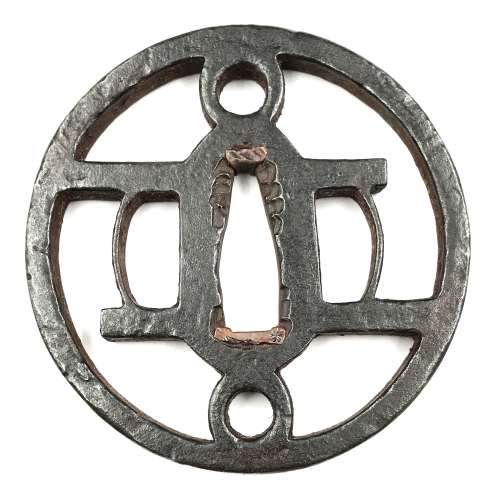 Iron tsuba of round form with design of two parallel crossbars and two rings in openwork (sukashi). Rounded square rim. Moderate iron bones (tekkotsu) allover. Copper sekigane. Kanayama school. Momoyama period (or late Muromachi). Size: 74.5 x 74.0 x 5.5 mm. The rings possibly represent the sun and the moon, or the stars. The parallel crossbars may represent the "two stripes" (futatsu biki) family crest (incl. Ashikaga family).
Iron tsuba of round form with design of two parallel crossbars and two rings in openwork (sukashi). Rounded square rim. Moderate iron bones (tekkotsu) allover. Copper sekigane. Kanayama school. Momoyama period (or late Muromachi). Size: 74.5 x 74.0 x 5.5 mm. The rings possibly represent the sun and the moon, or the stars. The parallel crossbars may represent the "two stripes" (futatsu biki) family crest (incl. Ashikaga family). -
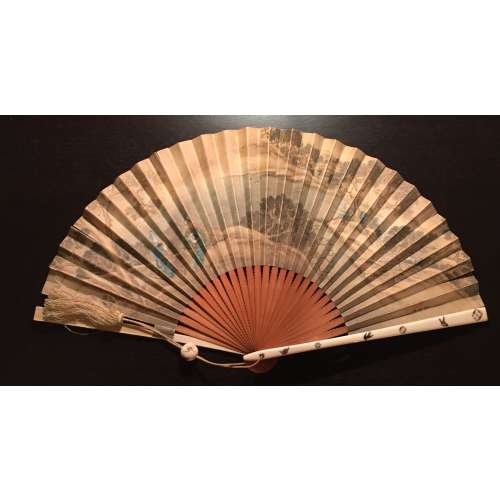 Late 19th-century (1850-1870) Japanese export fan. This fan has a double leaf painted with a different design on either side. Ivory encrusted with gemstones (birds and shippomon motif). Painting by ukiyo-e artist and printmaker Katsushika Isai (1821–1880) represents a riverside landscape with figures; birds and flowers on the reverse. Signed: Isai ga (為斎画) - "Painted by Isai".
Late 19th-century (1850-1870) Japanese export fan. This fan has a double leaf painted with a different design on either side. Ivory encrusted with gemstones (birds and shippomon motif). Painting by ukiyo-e artist and printmaker Katsushika Isai (1821–1880) represents a riverside landscape with figures; birds and flowers on the reverse. Signed: Isai ga (為斎画) - "Painted by Isai". -
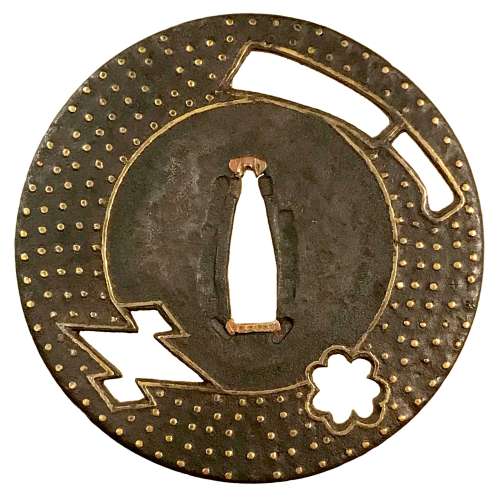
Iron tsuba of round form with design of hatchet, snowflake, and triple diamond in openwork (ko-sukashi), and inlaid with five concentric circles of brass dots (ten-zōgan) and brass inner circular line. Sukashi elements outlined in brass.
Late Muromachi period. Diameter: 82.4 mm; Thickness: 3.0 mm The triple lozenge (or diamond) is similar to the one on TSU-305 from Sasano Collection # 15. Very old motif; as Sasano remarks in his book "...represents the unstable political situation at the time".Kokusai Tosogu Kai 5th International Convention & Exhibition, October 28-30, 2009 at NEZU Museum, Tokyo, Japan, on page 83 provides the following explanation of the triple diamond symbol: "The pine bark is the form of the Diamonds, "Bishi", mon, seen from Nara period, found on cloth stored in the Shoso In, and used primarily by the Takeda family. The form of Bishi mon [similar to ours] is called "Chu Kage Matsukawa Bishi", (Middle Shaded Pine Bark Diamond)."
A combination of hatchet (usually an axe) and a triple diamond (Matsukawabishi) alludes to the Nō play Hachi-no-ki (ref: Iron tsuba. The works of the exhibition "Kurogane no hana", The Japanese Sword Museum, 2014; AND Sasano: Japanese Sword Guard Masterpieces from the Sasano Collection. By Sasano Masayuki. Part One. Published in Japan in 1994. -
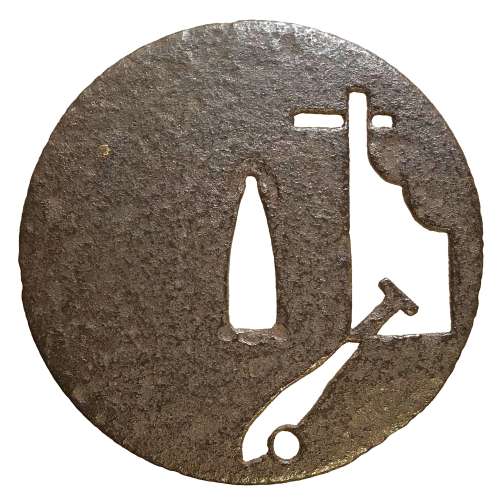 Round tsuba of iron; well forged thin plate decorated with a rudder (kaji) and an oar, or paddle (kai) with a water drop, executed in a combination of negative (in-sukashi) and positive (ji-sukashi) openwork. It may be Ko-Tōshō (old Tōshō) or just Tōshō school, without a 'Ko'. The characteristics of the plate point toward an older piece, however the combination of negative and positive silhouettes pulls the date of manufacture in an opposite direction. Muromachi period. Height: 90.0 mm. Width: 89.0 mm. Rim thickness: 2.1 mm. Center thickness: 2.3 mm. Nakago-ana: height = 29 mm, width = 8.8 mm. A rudder and an oar design is classified by John W. Dower as "Sailing vessels and gear": "Unlike many other motifs, sailing vessels and sailing gear failed to collect an interesting lore or to develop levels of meaning." Merrily Baird does not say anything about these symbols. Yuzuri Okada says: "Ships, sails, rudders, etc. also supply motive of the same class as wheels." He does not provide us with the description of the motive supplied by the wheel. The same motif is used on Ōnin tsuba in this collection:
Round tsuba of iron; well forged thin plate decorated with a rudder (kaji) and an oar, or paddle (kai) with a water drop, executed in a combination of negative (in-sukashi) and positive (ji-sukashi) openwork. It may be Ko-Tōshō (old Tōshō) or just Tōshō school, without a 'Ko'. The characteristics of the plate point toward an older piece, however the combination of negative and positive silhouettes pulls the date of manufacture in an opposite direction. Muromachi period. Height: 90.0 mm. Width: 89.0 mm. Rim thickness: 2.1 mm. Center thickness: 2.3 mm. Nakago-ana: height = 29 mm, width = 8.8 mm. A rudder and an oar design is classified by John W. Dower as "Sailing vessels and gear": "Unlike many other motifs, sailing vessels and sailing gear failed to collect an interesting lore or to develop levels of meaning." Merrily Baird does not say anything about these symbols. Yuzuri Okada says: "Ships, sails, rudders, etc. also supply motive of the same class as wheels." He does not provide us with the description of the motive supplied by the wheel. The same motif is used on Ōnin tsuba in this collection: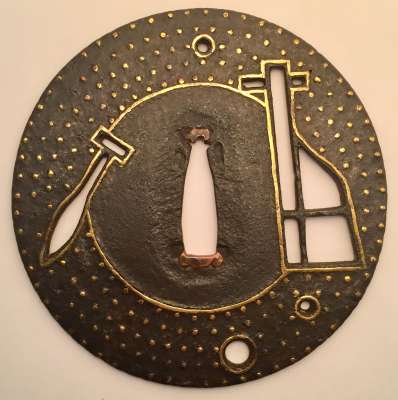
-
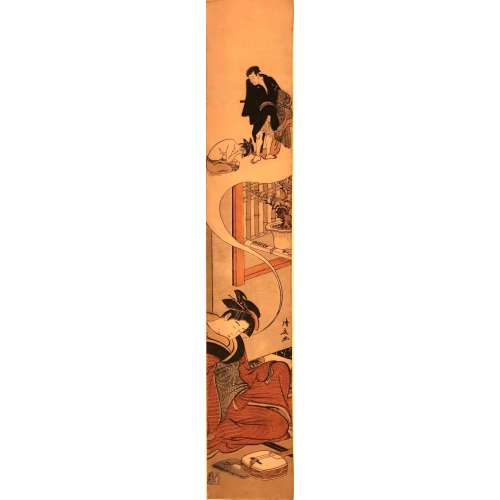 Torii Kiyonaga (1752-1815) Color woodblock print: hashira-e, 68.9 x 12.1 cm. DATE: 1783. Signed: Kiyonaga ga Publisher: Eijudō (Nishimuraya Yohachi) "Young musician dreams of being abducted by a ruffian. Long hours on duty have exhausted this young musician who sits sleeping with her shamisen and book placed on the ground in front of her. In her dream, she is being abducted by a ruffian who has stripped her of her clothing" [LIB-1474.2018: Important Japanese prints from the collection of Henry Steiner. Catalogue № 14. — NY: Sebastian Izzard LLC, 2018.]
Torii Kiyonaga (1752-1815) Color woodblock print: hashira-e, 68.9 x 12.1 cm. DATE: 1783. Signed: Kiyonaga ga Publisher: Eijudō (Nishimuraya Yohachi) "Young musician dreams of being abducted by a ruffian. Long hours on duty have exhausted this young musician who sits sleeping with her shamisen and book placed on the ground in front of her. In her dream, she is being abducted by a ruffian who has stripped her of her clothing" [LIB-1474.2018: Important Japanese prints from the collection of Henry Steiner. Catalogue № 14. — NY: Sebastian Izzard LLC, 2018.]The Japanese Pillar Print. Hashira-e. Jacob Pins. Foreword by Roger Keyes. Robert G. Sawers Publishing, London, 1982 [LIB-1543.2018 in this collection] -> page 262 №703: A young woman dreaming of rape and robbery. 1783. Hirano.
MFA: ACCESSION NUMBER 21.5546: Young Woman Music Teacher Dreaming of a Robbery [追剥の夢を見る三味線師匠]. Edo period, about 1783 (Tenmei 3). Artist Torii Kiyonaga (1752–1815), Publisher Nishimuraya Yohachi (Eijudô). Harvard Museums Object Number 1916.586: Female Musician Dreaming of Robbery. Edo period, circa 1783. Torii Kiyonaga, Japanese (1752 - 1815) . Published by Nishimuraya Yohachi. -
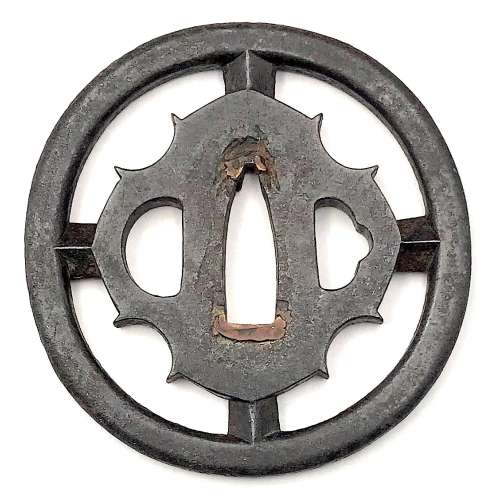 Iron tsuba of round form with slanting rays of light (shakoh) Christian motif (Jesuit's IHS symbol) in openwork (sukashi). Traditional description of this kind of design is called "tokei", or "clock gear". Edo period.
Iron tsuba of round form with slanting rays of light (shakoh) Christian motif (Jesuit's IHS symbol) in openwork (sukashi). Traditional description of this kind of design is called "tokei", or "clock gear". Edo period.Size: 77.7 x 76.1 x 6.7 mm.
For information regarding shakoh tsuba see article 'Kirishitan Ikenie Tsuba" by Fred Geyer at Kokusai Tosogu Kai; The 2nd International Convention & Exhibition, October 18-23, 2006, pp. 84-91. -
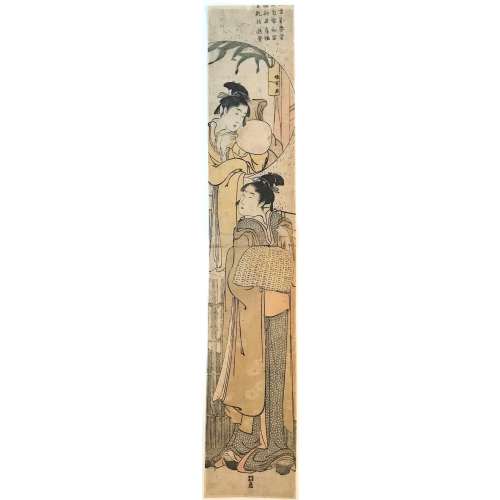 Woman Looking out a Round Window at a Woman with a Komusō Hat.
Woman Looking out a Round Window at a Woman with a Komusō Hat.Artist Koikawa Harumasa (a.k.a. Banki): fl. 1801–18. Wikipedia: Koikawa Harumasa (恋川 春政; active 1800–1820), later called Banki Harumasa (晩器 春政). Associated with Katsukawa school.
Signed: Banki ga (on the bamboo flower container in the background). Censor's seal: kiwame. Mark of unidentified publisher, Genshoku #1017; Marks U084 Ibiko, p. 387.
References:
Jacob Pins #828.
-
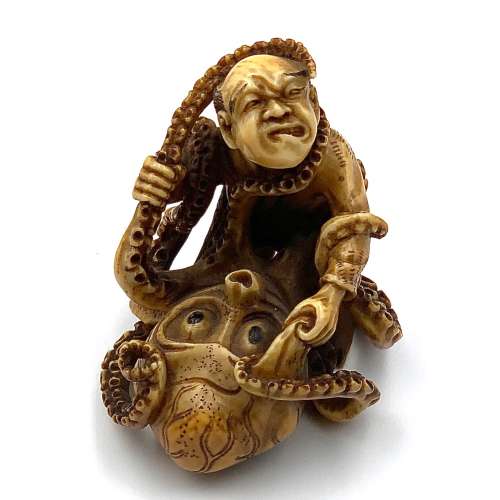
Ivory netsuke with a design of a man (possibly - Ariōmaru) wrestling a giant octopus.
Circa 1850. Dimensions: 45.5 x 48.3 x 37.8 mmUnsigned.
-
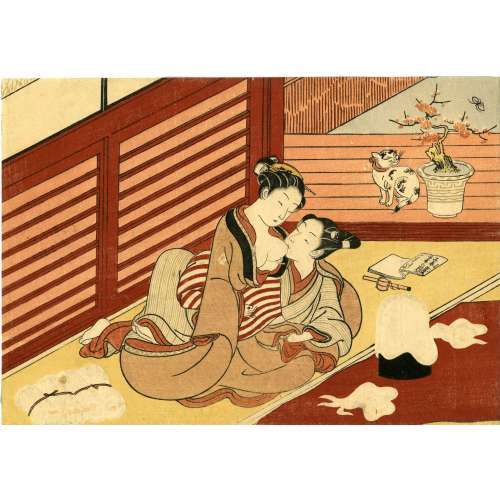 Artist (attributed, no signature): Suzuki Harunobu [鈴木 春信] (Japanese, c. 1725 – 1770). The title is taken from [LIB-1478.2013] Gian Carlo Calza, Stefania Piotti. Poem of the pillow and other stories. — Phaidon Press, 2010; pp. 148-9. Alternative title: Man sucking woman's breast and a cat sitting under a bonsai tree. The open book beside the couple reads 子春 (Koharu). Woodblock print from the series Mirror Picture of Japan (Wakoku kagami); Size: Horizontal chuban; 21 x 26 cm.
Artist (attributed, no signature): Suzuki Harunobu [鈴木 春信] (Japanese, c. 1725 – 1770). The title is taken from [LIB-1478.2013] Gian Carlo Calza, Stefania Piotti. Poem of the pillow and other stories. — Phaidon Press, 2010; pp. 148-9. Alternative title: Man sucking woman's breast and a cat sitting under a bonsai tree. The open book beside the couple reads 子春 (Koharu). Woodblock print from the series Mirror Picture of Japan (Wakoku kagami); Size: Horizontal chuban; 21 x 26 cm. -
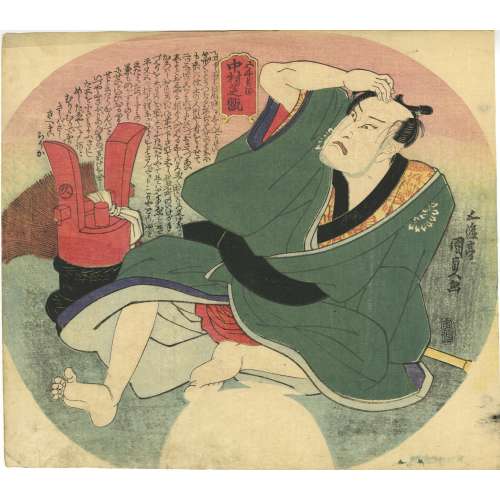 Artist: Utagawa Kunisada [歌川 国貞] a.k.a. Utagawa Toyokuni III [三代歌川豊国] (Japanese, 1786 – 1865). Signed: Gototei Kunisada ga [五渡亭国貞画]. Publisher: Ibaya Kyūbei [伊場屋 久兵衛] (Japanese, 1804 – 1851); seal Marks 08-055|126a. Date-aratame seal: Bunsei 13 / Tenpō 1 (1830). Actor: Nakamura Utaemon IV [中村歌右衛門] (Japanese, 1796 – 1852); other names: Nakamura Shikan II [中村芝翫], Nakamura Tsurusuke I, Nakamura Tōtarō. Play: Yoshitsune’s Letter at Koshigoe [義経腰越状] (Yoshitsune Koshigoe-jo). Uncut fan print (uchiwa-e, 団 扇 絵) depicting kabuki actor Nakamura Shikan [中村芝翫] as Gotobei [五斗兵衛], dressed in a green kimono with hanging wisteria crest (sagari fuji mon) on the shoulder, posing behind a large saké cask. Nakamura Utaemon IV held the name of Nakamura Shikan II from the 11th lunar month of 1825 to the 1st lunar month of 1836. He was born as Hirano Kichitarō in Edo in 1796. Another fan print with the same subject in this collection [SVJP-0349.2021]; there are also more details about the play and its heroes.
Artist: Utagawa Kunisada [歌川 国貞] a.k.a. Utagawa Toyokuni III [三代歌川豊国] (Japanese, 1786 – 1865). Signed: Gototei Kunisada ga [五渡亭国貞画]. Publisher: Ibaya Kyūbei [伊場屋 久兵衛] (Japanese, 1804 – 1851); seal Marks 08-055|126a. Date-aratame seal: Bunsei 13 / Tenpō 1 (1830). Actor: Nakamura Utaemon IV [中村歌右衛門] (Japanese, 1796 – 1852); other names: Nakamura Shikan II [中村芝翫], Nakamura Tsurusuke I, Nakamura Tōtarō. Play: Yoshitsune’s Letter at Koshigoe [義経腰越状] (Yoshitsune Koshigoe-jo). Uncut fan print (uchiwa-e, 団 扇 絵) depicting kabuki actor Nakamura Shikan [中村芝翫] as Gotobei [五斗兵衛], dressed in a green kimono with hanging wisteria crest (sagari fuji mon) on the shoulder, posing behind a large saké cask. Nakamura Utaemon IV held the name of Nakamura Shikan II from the 11th lunar month of 1825 to the 1st lunar month of 1836. He was born as Hirano Kichitarō in Edo in 1796. Another fan print with the same subject in this collection [SVJP-0349.2021]; there are also more details about the play and its heroes.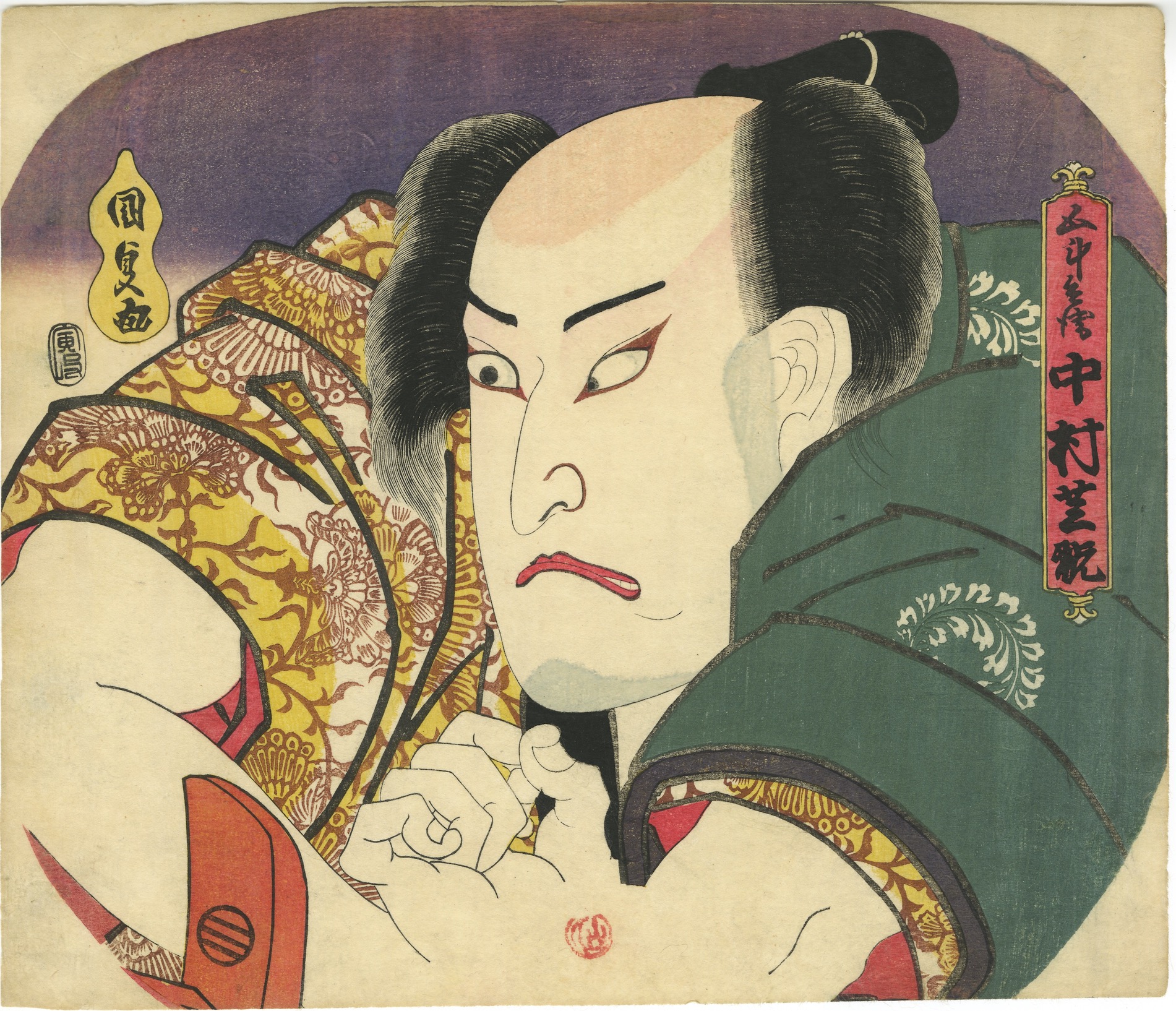 Horst Graebner also noted that the performance took place at Nakamura Theatre in Edo on Bunsei 13/03 (03/1830) (see Waseda University Cultural Resources Database # 100-4224):
Horst Graebner also noted that the performance took place at Nakamura Theatre in Edo on Bunsei 13/03 (03/1830) (see Waseda University Cultural Resources Database # 100-4224):
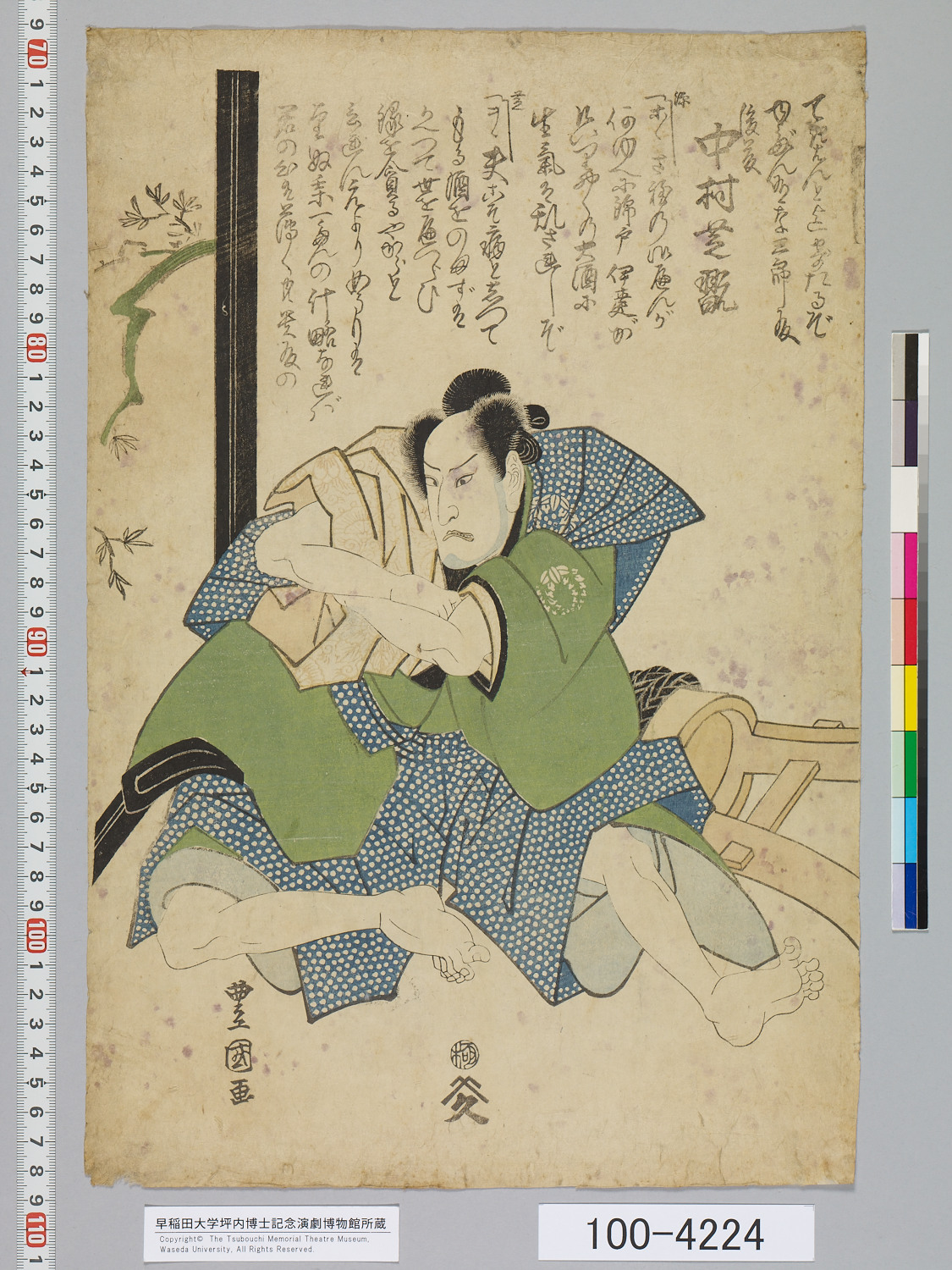
Toyokuni II
-
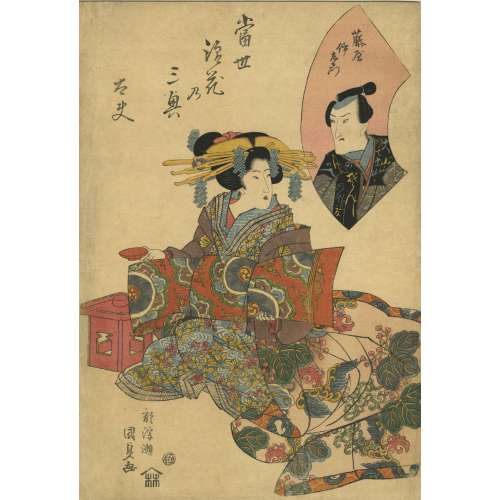 The central sheet of (optional) triptych: Courtesan (Tayū): kabuki actor Bandō Mitsugorō III as Fujiya Izaemon from Three pleasures of present-day Osaka (Tōsei Naniwa no sankō)「当世浪花の三興 太夫」 「藤屋伊左衛門」 三代目坂東三津五郎. Publisher: Iseya Rihei [伊勢屋利兵衛] (Japanese, fl. 1790s – c. 1879) Year: 1821 (Bunsei 4). Size: Vertical ōban; 36.5 x 25.1 cm. Signed: 於浮瀬亭国貞画 – Drawn by Kunisada in Ukabuse (Ukabuse ni oite Kunisada ga). Ukabuse is the name of a famous restaurant in Osaka, this signature can be found only on a three print bijin series [Kunisada Project]. Censor's seal: kiwame 改印:極 Actor Bandō Mitsugorō III [三代目 坂東 三津五郎] (Japanese, 1775 – 1831); other names: Bandō Minosuke I, Morita Kanjirô II, Bandō Mitahachi I, Bandō Minosuke I, Bandō Mitahachi I. Character: Fujiya Izaemon. Ref: MFA ACCESSION NUMBER 11.21937; LIB-2967.2022 Izzard. Full series (triptych) Three Pleasures of Present-day Osaka (Tōsei Naniwa no sankō):
The central sheet of (optional) triptych: Courtesan (Tayū): kabuki actor Bandō Mitsugorō III as Fujiya Izaemon from Three pleasures of present-day Osaka (Tōsei Naniwa no sankō)「当世浪花の三興 太夫」 「藤屋伊左衛門」 三代目坂東三津五郎. Publisher: Iseya Rihei [伊勢屋利兵衛] (Japanese, fl. 1790s – c. 1879) Year: 1821 (Bunsei 4). Size: Vertical ōban; 36.5 x 25.1 cm. Signed: 於浮瀬亭国貞画 – Drawn by Kunisada in Ukabuse (Ukabuse ni oite Kunisada ga). Ukabuse is the name of a famous restaurant in Osaka, this signature can be found only on a three print bijin series [Kunisada Project]. Censor's seal: kiwame 改印:極 Actor Bandō Mitsugorō III [三代目 坂東 三津五郎] (Japanese, 1775 – 1831); other names: Bandō Minosuke I, Morita Kanjirô II, Bandō Mitahachi I, Bandō Minosuke I, Bandō Mitahachi I. Character: Fujiya Izaemon. Ref: MFA ACCESSION NUMBER 11.21937; LIB-2967.2022 Izzard. Full series (triptych) Three Pleasures of Present-day Osaka (Tōsei Naniwa no sankō):


-
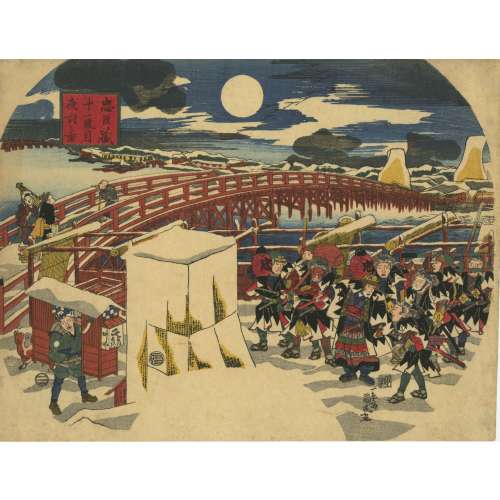 Artist: Utagawa Kunimaru [歌川国丸] (Japanese, 1794 – 1829). Publisher: Ibaya Senzaburō [伊場屋 仙三郎] (fl. 1815 – 1869). Date-kiwame seal: Bunsei 10 (1827). Signed: Ichiensai Kunimaru ga [一円斎国丸画]. Play: Chūshingura [忠臣蔵] (The Treasury of Loyal Retainers), 11th act, Night Battle [十一段目夜討之図]. Act XI: The Attack on Kō no Moronao Mansion. Kō no Moronao [高 師直] (Japanese, d. 1351). Ref: Ako City Museum of History Inscription on the soba peddler box: Nihachi soba udon [二八そば うどん] – twice eight soba and udon (16 mon per serving).
Artist: Utagawa Kunimaru [歌川国丸] (Japanese, 1794 – 1829). Publisher: Ibaya Senzaburō [伊場屋 仙三郎] (fl. 1815 – 1869). Date-kiwame seal: Bunsei 10 (1827). Signed: Ichiensai Kunimaru ga [一円斎国丸画]. Play: Chūshingura [忠臣蔵] (The Treasury of Loyal Retainers), 11th act, Night Battle [十一段目夜討之図]. Act XI: The Attack on Kō no Moronao Mansion. Kō no Moronao [高 師直] (Japanese, d. 1351). Ref: Ako City Museum of History Inscription on the soba peddler box: Nihachi soba udon [二八そば うどん] – twice eight soba and udon (16 mon per serving). -
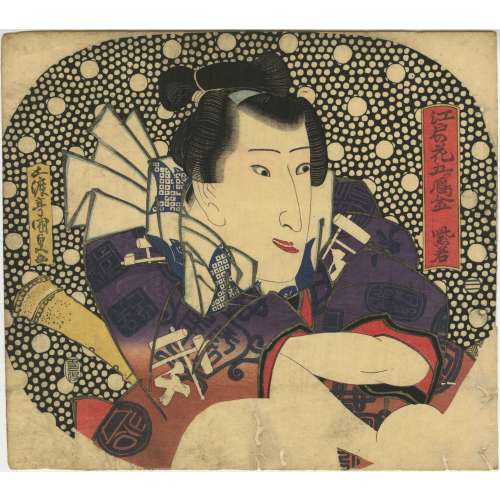 Artist: Utagawa Kunisada, a.k.a. Toyokuni III (Japanese, 1786 – 1865) [歌川 国貞]. Publisher: Ibaya Senzaburō [伊場屋仙三郎] (Japanese, fl. C. 1845 – 1847). Date aratame seal: Bunsei 12 (1829). Signed: Gototei Kunisada ga [五渡亭国貞画]. Media: Fan print (uchiwa-e), 238 x 267 mm (overtrimmed). Actor: Iwai Shijaku I [紫若] (Japanese, 1804 – 1845); other names: Iwai Matsunosuke I [岩井松之助]; Iwai Hanshirō VII, Iwai Shijaku I, Iwai Komurasaki I. The background is Arare-ko-mon [霰小紋] hail pattern. In the red cartouche at the top right is the series title "Edo no hana – itsutsu Karigane" (江戸の花 五雁金), to be translated as "Flowers of Edo - the five Karigane blood-brothers" (or "the five Karigane gang members"). Another print from the series in this collection: SVJP-0304.2019.
Artist: Utagawa Kunisada, a.k.a. Toyokuni III (Japanese, 1786 – 1865) [歌川 国貞]. Publisher: Ibaya Senzaburō [伊場屋仙三郎] (Japanese, fl. C. 1845 – 1847). Date aratame seal: Bunsei 12 (1829). Signed: Gototei Kunisada ga [五渡亭国貞画]. Media: Fan print (uchiwa-e), 238 x 267 mm (overtrimmed). Actor: Iwai Shijaku I [紫若] (Japanese, 1804 – 1845); other names: Iwai Matsunosuke I [岩井松之助]; Iwai Hanshirō VII, Iwai Shijaku I, Iwai Komurasaki I. The background is Arare-ko-mon [霰小紋] hail pattern. In the red cartouche at the top right is the series title "Edo no hana – itsutsu Karigane" (江戸の花 五雁金), to be translated as "Flowers of Edo - the five Karigane blood-brothers" (or "the five Karigane gang members"). Another print from the series in this collection: SVJP-0304.2019. -
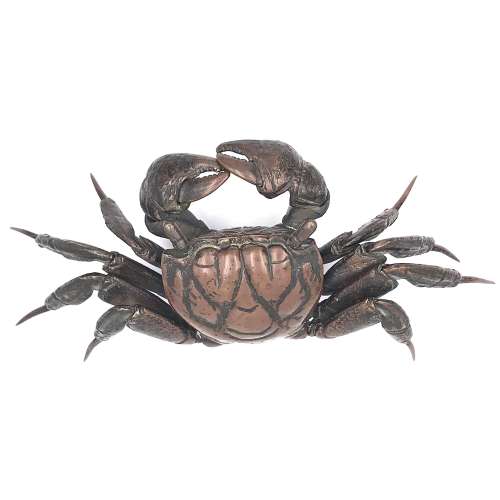 Jizai okimono bronze articulated model of a crab. Japan, Meiji period(1868-1912). Size: Body: 6.5 x 6 cm. Total: 23 x 11 cm. Weight: 762 g
Jizai okimono bronze articulated model of a crab. Japan, Meiji period(1868-1912). Size: Body: 6.5 x 6 cm. Total: 23 x 11 cm. Weight: 762 g -
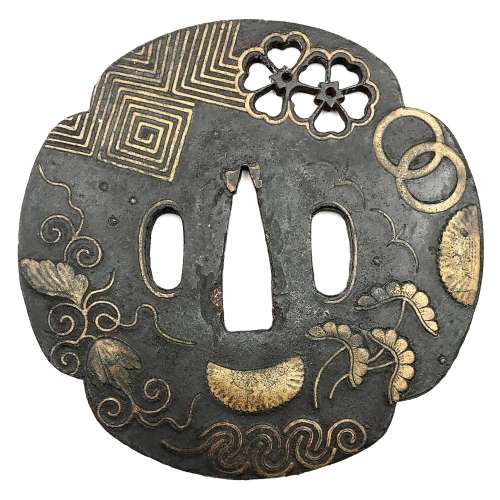 Iron tsuba of mokko form (quatrefoil) decorated with a pair of cherry blossoms (sakura) in small openwork (ko-sukashi) and inlaid in brass (suemon-zōgan) with designs of waves, distant pines, chrysanthemum flowers in halves, tendrils and leaves, lightning or thunder symbol (inazuma), flying geese and family chrests (mon): two interlocked rings (wachigai) on the face, and three encircled stripes (maru-no-uchi-ni-mitsuhikiryo) - kamon of the Kikkawa clan - on the reverse. Hitsu-ana outlined with inlay of brass wire. Surface treated with lacquer. Copper sekigane. Though some consider this type of tsuba to resemble Heianjo school, “...the brass trim around the hitsu-ana is a characteristics of Ōnin work” [Japanese sword guards. Onin – Heianjo – Yoshiro. Gary D. Murtha. GDM Publications, 2016; p. 27.]. The Ōnin origin is reinforced by scattered ten-zōgan elements here and there through the plate. It is possible that the tsuba was initially of round form and later trimmed to mokko shape. Mid Muromachi period; 15th century. Dimensions: Height: 87.2 mm; Width: 87.9 mm; Thickness at seppa-dai: 3.6 mm.
Iron tsuba of mokko form (quatrefoil) decorated with a pair of cherry blossoms (sakura) in small openwork (ko-sukashi) and inlaid in brass (suemon-zōgan) with designs of waves, distant pines, chrysanthemum flowers in halves, tendrils and leaves, lightning or thunder symbol (inazuma), flying geese and family chrests (mon): two interlocked rings (wachigai) on the face, and three encircled stripes (maru-no-uchi-ni-mitsuhikiryo) - kamon of the Kikkawa clan - on the reverse. Hitsu-ana outlined with inlay of brass wire. Surface treated with lacquer. Copper sekigane. Though some consider this type of tsuba to resemble Heianjo school, “...the brass trim around the hitsu-ana is a characteristics of Ōnin work” [Japanese sword guards. Onin – Heianjo – Yoshiro. Gary D. Murtha. GDM Publications, 2016; p. 27.]. The Ōnin origin is reinforced by scattered ten-zōgan elements here and there through the plate. It is possible that the tsuba was initially of round form and later trimmed to mokko shape. Mid Muromachi period; 15th century. Dimensions: Height: 87.2 mm; Width: 87.9 mm; Thickness at seppa-dai: 3.6 mm. -
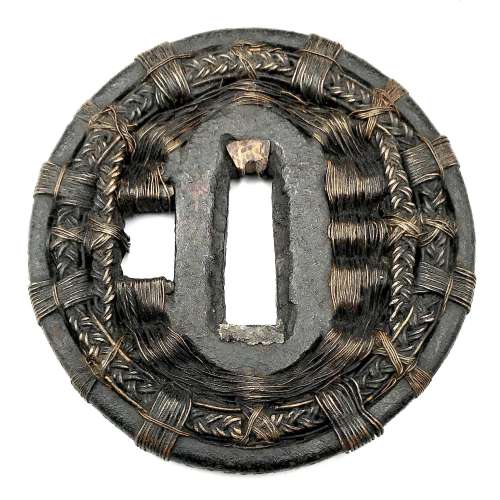 Shingen school tsuba with woven wire pattern. Iron core, woven brass wire. Height: 72.5 mm; Width 69.8 mm; Thickness at seppa-dai: 4.0 mm. Weight 88.8 g. Late Muromachi, 16th century. SOLD http://varshavskycollection.com/shingen-tsuba/
Shingen school tsuba with woven wire pattern. Iron core, woven brass wire. Height: 72.5 mm; Width 69.8 mm; Thickness at seppa-dai: 4.0 mm. Weight 88.8 g. Late Muromachi, 16th century. SOLD http://varshavskycollection.com/shingen-tsuba/ -
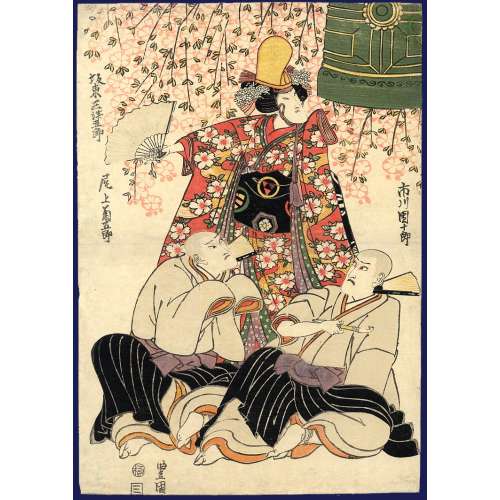 Artist: Utagawa Toyokuni I (1769–1825) Title: Actors Bando Mitsugorō, Ichikawa Danjūrō, Onoe Kikugorō in play The Maiden at Dōjō Temple. Presumably Bunka 13 (1816) at Nakamura Theater in Edo. Publisher: Mikawaya Seiemon (c. 1805-1829); Marks' "Publishers" № 328, p. 235. Size: Vertical ôban MEDIUM OR TECHNIQUE: Woodblock print (nishiki-e); ink and color on paper. Signed: Toyokuni ga Censor's seal: kiwame Detailed discussion on the topic can be seen at: The Maiden at Dōjō Temple
Artist: Utagawa Toyokuni I (1769–1825) Title: Actors Bando Mitsugorō, Ichikawa Danjūrō, Onoe Kikugorō in play The Maiden at Dōjō Temple. Presumably Bunka 13 (1816) at Nakamura Theater in Edo. Publisher: Mikawaya Seiemon (c. 1805-1829); Marks' "Publishers" № 328, p. 235. Size: Vertical ôban MEDIUM OR TECHNIQUE: Woodblock print (nishiki-e); ink and color on paper. Signed: Toyokuni ga Censor's seal: kiwame Detailed discussion on the topic can be seen at: The Maiden at Dōjō Temple -
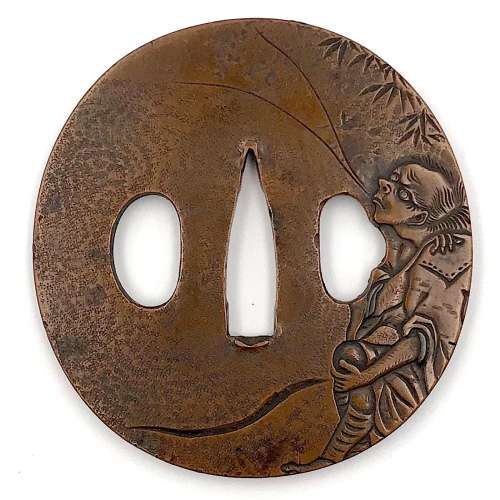
Copper tsuba of oval form carved in kebori and katakiribori with Tekkai Sennin sitting under bamboo on the face and with a pine tree on the back. Ishime-ji treated surface.
Signed on the reverse: Jōi (乗 意).
Edo period (First half of 18th century). Dimensions: 69.6 x 66.5 x 4.5 mm Sugiura Jōi (杉 浦 乗 意) was a master of Nara School in Edo; he was a student of Toshinaga [M. Sesko, 'Genealogies', p. 32]. "Sugiura Jōi (1701-1761) made many fuchigashira and kozuka, tsuba are rather rare." [M. Sesko, The Japanese toso-kinko Schools].


